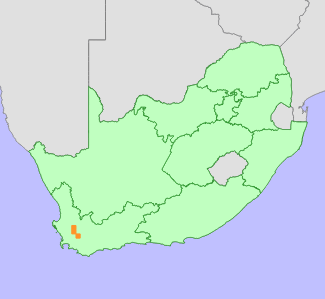|
Scientific Name | Ixia campanulata Houtt. |
Higher Classification | Monocotyledons |
Family | IRIDACEAE |
Synonyms | Gladiolus coccineus (Thunb.) Schrank, Ixia anemonaeflora Jacq., Ixia aristata Thunb., Ixia coccinea Eckl. (later homonym), not of Thunb. (1811), Ixia coccinea Thunb., Ixia concolor Salisb., Ixia crateroides Ker Gawl. (superfluous name for Ixia speciosa Andrews), Ixia leucantha Jacq. var. aristata (Thunb.) Baker, Ixia speciosa Andrews |
Common Names | Rooikalossie (a) |
National Status |
Status and Criteria | Critically Endangered B2ab(i,ii,iii,iv,v) |
Assessment Date | 2015/06/08 |
Assessor(s) | P. Goldblatt, J.C. Manning, I. Ebrahim, D. Raimondo & L. von Staden |
Justification | EOO 254 km², AOO <7 km², two, possibly three, small, severely fragmented subpopulations remain after more than 60% habitat loss to agricultural expansion. Population decline due to ongoing habitat loss and degradation continues. |
Distribution |
Endemism | South African endemic |
Provincial distribution | Western Cape |
Range | Breede River Valley between Tulbagh and Worcester. |
Habitat and Ecology |
Major system | Terrestrial |
Major habitats | Breede Alluvium Renosterveld, Breede Shale Fynbos, Breede Sand Fynbos, Swartland Alluvium Fynbos, Breede Alluvium Fynbos |
Description | Sandy alluvial flats and lower slopes. |
Threats |
| Agricultural expansion has irreversibly modified more than 60% of this species' habitat, and only small, isolated fragments remain. Habitat loss and degradation continues in these fragments due to inappropriate fire management, grazing, and spreading, unmanaged alien invasive plants. |
Population |
This species is known from many historical records in the Tulbagh Valley. A systematic survey of all remaining fynbos and renosterveld fragments in the Tulbagh Valley in 2005 located only one surviving subpopulation (I. Ebrahim pers. comm.) on a 194 hectare fragment at the foot of the Groot Winterhoek Mountains. Another isolated subpopulation was recently recorded on a 133 hectare fragment near Goudini, about 45 km from the Tulbagh subpopulation. A third subpopulation near the Brandvlei Dam last recorded in 1983 possibly still remains, but alluvial flats in this area are severely degraded, and surveys are needed to confirm its persistence.
|
Population trend | Decreasing |
Assessment History |
Taxon assessed |
Status and Criteria |
Citation/Red List version | | Ixia campanulata Houtt. | CR B2ab(i,ii,iii,iv,v) | 2015.1 | | Ixia campanulata Houtt. | EN B1ab(ii,iii,iv,v) | Raimondo et al. (2009) | | Ixia campanulata Houtt. | Endangered | Hilton-Taylor (1996) | |
Bibliography |
De Vos, M.P. 1999. Ixia. In: O.A. Leistner (ed). Flora of Southern Africa 7 Iridaceae Part 2: Ixioideae, Fascicle 1: Ixieae:3-87. National Botanical Institute, Pretoria.
Goldblatt, P. and Manning, J.C. 2000. Cape Plants: A conspectus of the Cape Flora of South Africa. Strelitzia 9. National Botanical Institute, Cape Town.
Goldblatt, P. and Manning, J.C. 2016. Systematics of the southern African genus Ixia L. (Iridaceae): 5. Synopsis of section Ixia, including five new species. South African Journal of Botany 104:175-198.
Hilton-Taylor, C. 1996. Red data list of southern African plants. Strelitzia 4. South African National Botanical Institute, Pretoria.
Lewis, G.J. 1962. South African Iridaceae. The genus Ixia. Journal of South African Botany 28:45-195.
Raimondo, D., von Staden, L., Foden, W., Victor, J.E., Helme, N.A., Turner, R.C., Kamundi, D.A. and Manyama, P.A. 2009. Red List of South African Plants. Strelitzia 25. South African National Biodiversity Institute, Pretoria.
|
Citation |
| Goldblatt, P., Manning, J.C., Ebrahim, I., Raimondo, D. & von Staden, L. 2015. Ixia campanulata Houtt. National Assessment: Red List of South African Plants version . Accessed on 2025/05/31 |
 Comment on this assessment
Comment on this assessment

